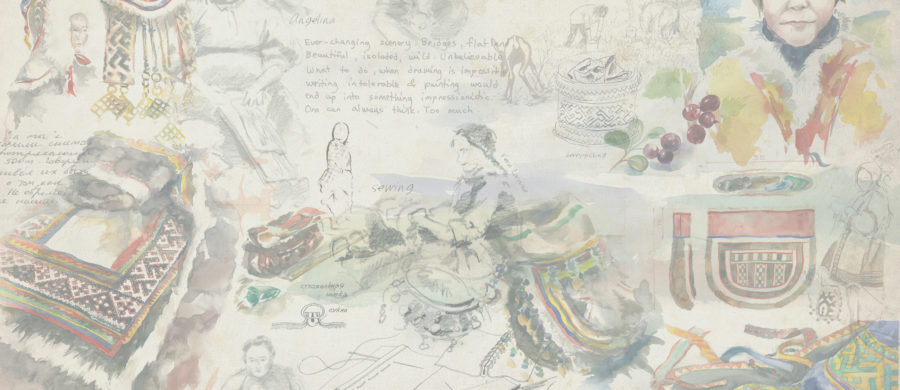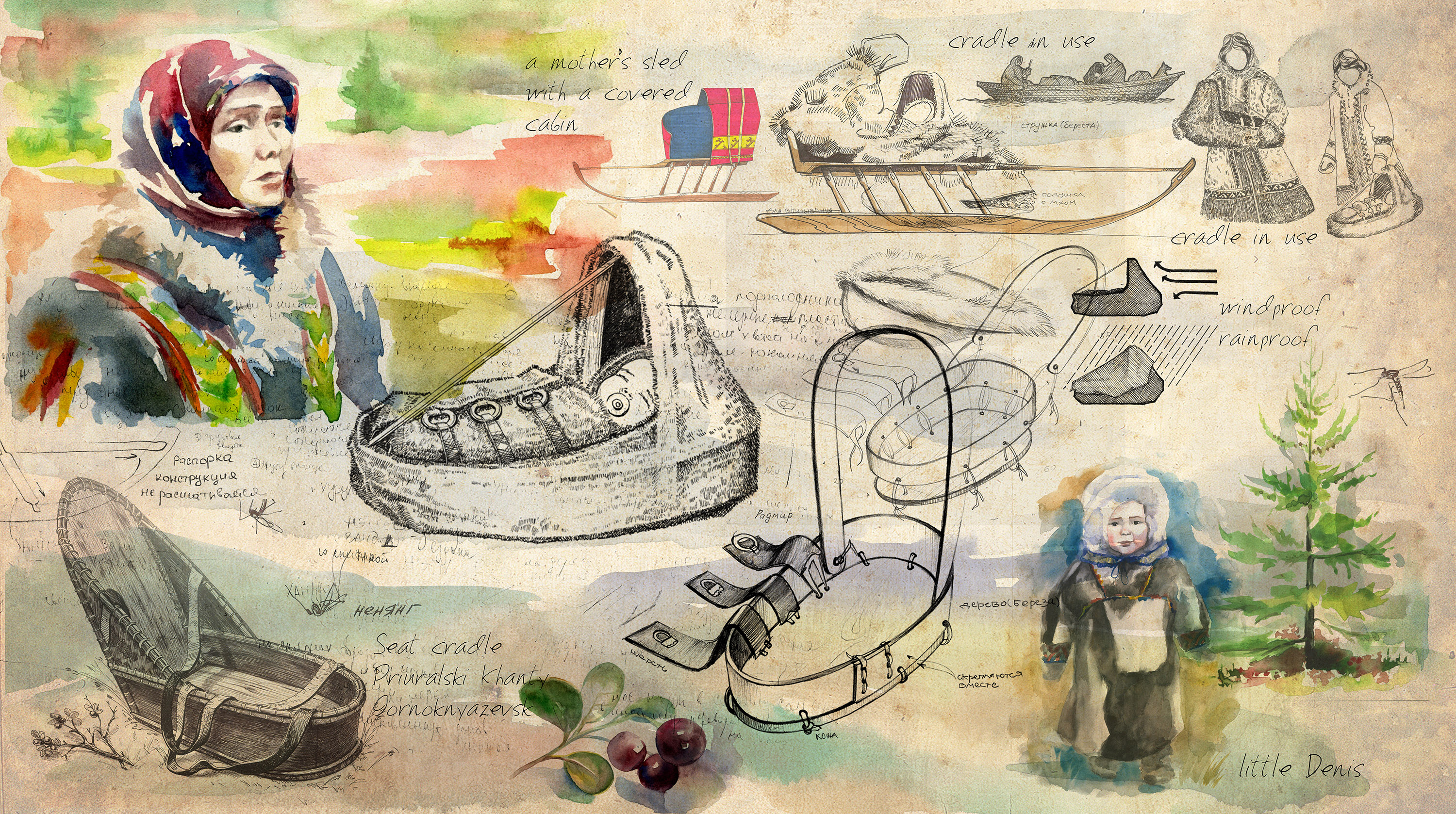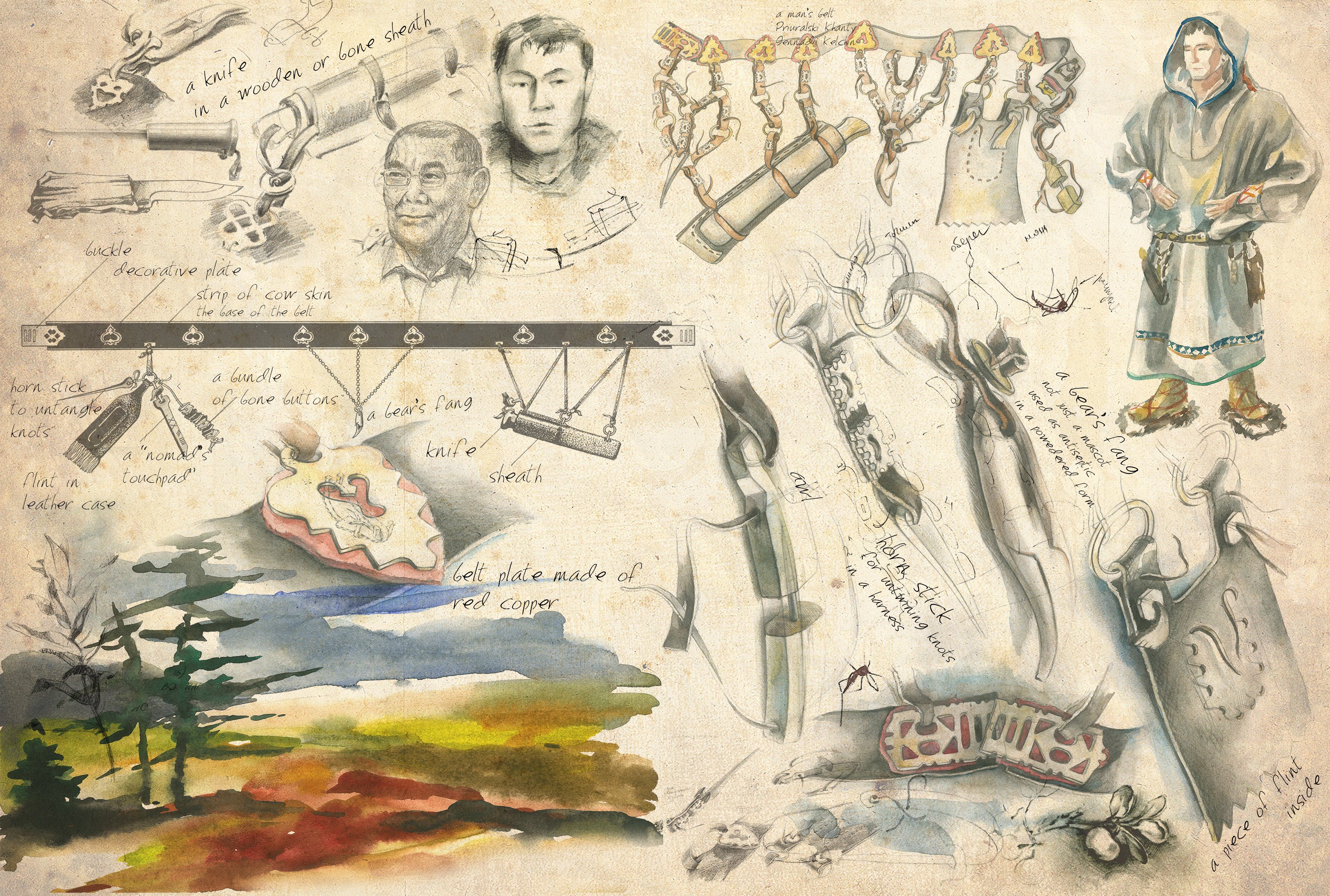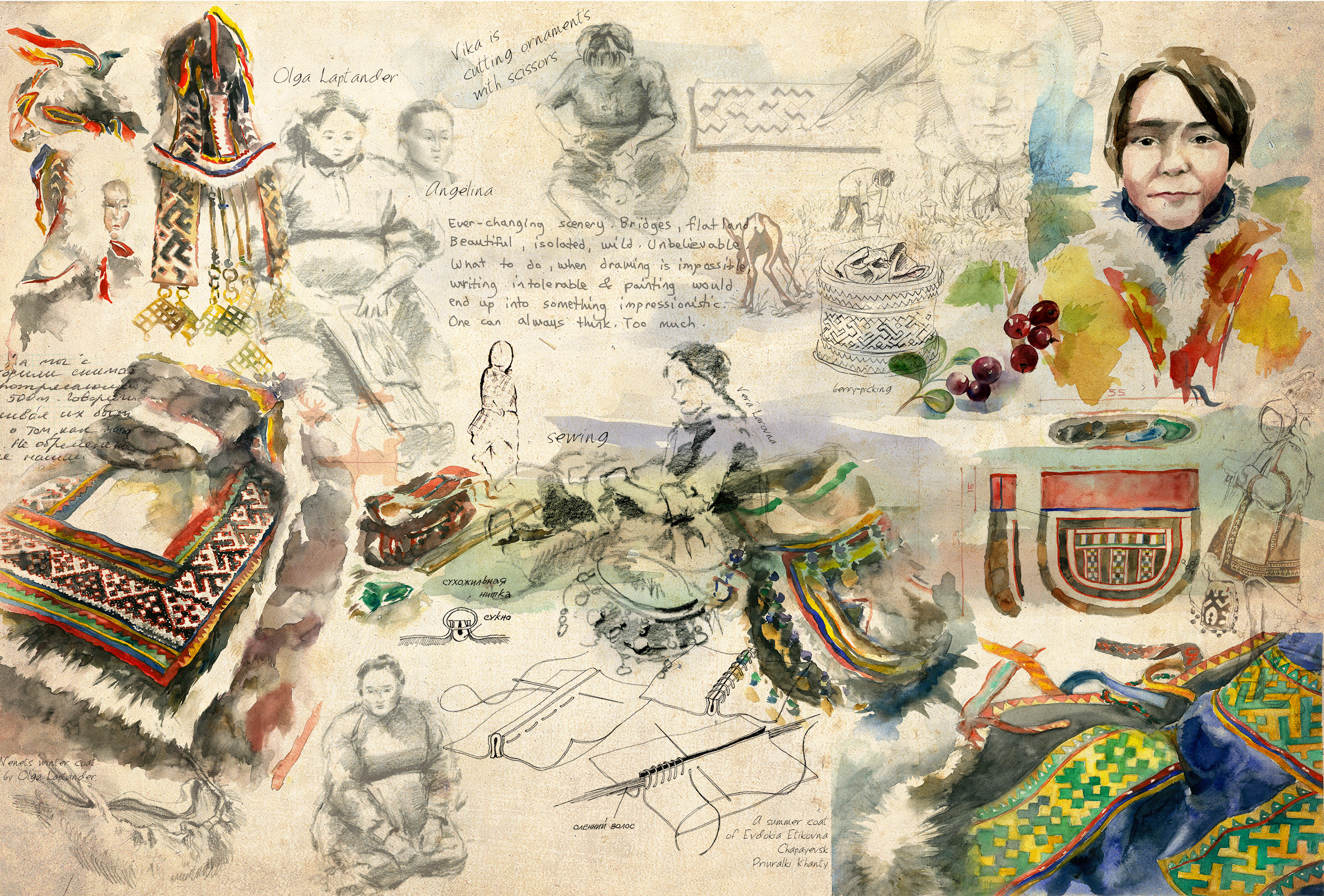
Arctic Human Enhancement: Focusing on Traditional Technologies of Arctic Indigenous People (Designerly Field Notes)
Technology’s Stories vol. 5, no. 2 – doi:10.15763/JOU.TS.2017.5.9.01
PDF: Usenyuk-Kravchuk_Arctic Enhancement
Introduction
Arctic indigenous peoples are widely recognized as living examples of successful adaptation to severe environmental conditions. However, ethnographic and anthropological studies tend to focus mainly on immaterial “traditional knowledge,” while tangible artifacts and practices, related skills and technologies that still constitute the very existence of these communities remain largely unexplored. In this essay we suggest an alternative – designerly – look into the culture of Arctic natives in order to get closer to discovering secrets of withstanding extreme and ever-changing natural circumstances. We take as our starting point the concept of human enhancement, which generally means “any attempt to temporarily or permanently overcome the current limitations of the human body through natural or artificial means”.[1]
In our vision, the idea of human enhancement with regard to the Arctic differs significantly from the general definition, which implies self-managed design alternatives for the “natural” human body. The Arctic presents a unique setting, where throughout the history of human presence the challenges of nature have encouraged a strong reliance on technology, so the Arctic human is the one technologically augmented from the very emergence.[2]
Our research experience is rooted in studying indigenous herders and hunters of Western Siberia, i.e. Khanty, Mansi and Nenets. In this essay – a part of a larger research project exploring principles of adaptation to extreme environment through man-made things – we present the results of “firsthand exposure to people, places, and things”, which provided understanding and inspiration rather than mere scientific data.[3] The three cases that follow are drawn from our long-term fieldwork in West Siberia, the Yamal Peninsula and the Polar Urals. The process of “gaining an empathic grasp” is presented by the means of visual arts – sketches, drawings, paintings, etc. – with their natural dynamics and personalized attitude.[4] These are three stories of human enhancement through traditional technological artifacts and wearables as specially designed/constructed “superpowers.”
A child’s cradle
“To survive in such severe conditions, we invented … a spaceship! It protects the emerged life and allows it to travel in space-time…”
Gennady Kelchin, the Khanty, Salekhard, 2013
A baby cradle – apa – is, indeed, a “spaceship” for a little nomad: it is a micro-scale mobile house, inside which s/he has to migrate in any weather and at any time of the year. Invented centuries ago and still in use today without any distinctive design changes, the apa, to a large extent, resembles the shape of a modern travel baby carriage. There is also a seat version similar to today’s design of infant car seats.
Examining the structure of the apa through the lens of mobility and protection “on the go”, we can discover the main factor that influenced its shape, i.e. the wind. Let us look closer at the specific elements and materials that together constitute the “superpower” of the apa, i.e. its exceptional ability to protect a newborn from this most adverse environmental factors in the all-weather tundra.
The apa is made of thin, light birch slats with a transverse, vertically placed arc in the front part of the structure. The cradle design is perfectly adapted to the nomadic way of living: sometimes tied to a sled, or to a tent pole, or simply to a tree branch, it is convenient for carrying by hand, transporting by sled or boat. The apa is very stable: if it is rolled over (e.g. it can drop out of the sled during migration), it would behave like a “tilting doll,” i.e. immediately resuming its rest position.
The main protective element is a distinctive windshield made of (reindeer) suede or calf hide stretched between the vertical arc and the head side of the cradle. The edges of the cradle are low, i.e. reaching slightly below the child wrapped in skins and fastened with straps to the cradle’s sides. This height together with the windshield enables the wind or a counter flow of cold air to gently round the cradle from the front, without bothering the child inside. With a sharper wind or snowstorm, an extra fur cover can be attached to the frame between vertical arc and the feet side of the cradle. Thus, the cradle is fully covered, with a small hole left for breathing. This, overall, resembles a child-sized version of a nomadic dwelling unit, i.e. a portable conical shelter with a hole on the top, as well as of a personal sleeping bag.
In brief, the cradle has two “windproof modes”: (1) a partially covered shelter set up against the wind direction, which is at any time ready to turn into (2) a fully protected “spaceship” with a windproof outer layer made of reindeer fur.

Figure 1. The cradle. Drawings by: A. Belyaeva, N. Garin, R. Gelmutdinov, I. Polyanskikh.
In the light of human enhancement, the cradle case illuminates the significance of proper equipment as a tangible form of adaptation to the extreme environment: from the very beginning of life, the only possible human specimen to exist in the Arctic is a technologically protected/enhanced human.
Among the belongings of an Arctic native there are special things, from which the adulthood of a man or woman begins. These are, indeed, the most important and extremely necessary objects, without which a person cannot survive in the tundra or taiga. The next story moves us to men’s world, and to its key artifact, i.e. a belt.
A man’s belt
“The clothes are a man’s second skin, and the belt is his armor: it is the very essence of him, but invulnerable”
Olga Laptander, the Nenets, Baidarat tundra, 2013
For the Arctic native, the belt is more than just utilitarian accessory; it is a “tangible ID” representing his social status and power. “No need to say much when you meet someone, you both can get to know each other simply by looking at your belts” (Viktor Laptander, the Nenets, Baidarat tundra, 2013). The process of a boy’s initiation includes putting on a belt (at the age of 13), and after this he is considered a mature man, i.e. . This belt – with gradually obtains additional elements, with repairs and replacements, etc. – remains with its owner throughout his life until his death.
The “human enhancement” lens focuses our attention on the structure and content of the belt. Functionally, it is the bearer of necessities for hunting and herding, as well as of weapons and cooking/eating utensils.
The first and foremost object on the belt is a knife. It is a key wearable in the array of an arctic man’s belongings. Almost every action in a man’s life begins with the knife. The knife identifies the person himself; this is his signature under actions and achievements. In terms of physical enhancement, the knife is, indeed, the most important prosthetic tool – literally the sixth finger – that aids and enhances the human body. On the belt, a man carries up to seven knives, and each of them has a strictly determined function. The set includes: a knife for carving carcasses; a so-called “making knife” used to make everything from a spoon to a boat; a healing knife used for simple surgeries; and even a “moon” knife or a “knife for love”… There is also a knife for war, which is placed last in the hanging set of knives and gets in use only in the most extreme case.
Next to the set of knives there is a leather-cased grindstone. From the backside there is a garland of bears’ or wolfs’ fangs that represents a distinctive hunting mastery of the owner. On the side there is a set of multi-shaped – oblong, round, square – bone “buttons,” i.e. fixing elements of reindeer harness. There is a leather-cased bone awl used for untying the knots, especially in wet weather. Then there is a so-called “portable computer,” i.e. several flat wooden sticks, where the reindeer herder “codes”/carves the necessary information related to the reindeer herd (the number of calves, males, sick and/or vaccinated animals, etc.). The crown of the belt is a heavy buckle made of sheet or cast brass with a sawdust pattern. The entire surface of the belt made of a cow’s skin – thick and durable – is decorated with antique patterned details or buttons made of brass or red copper, necessarily of the odd number. The materials of the belt’s elements also matter: scratching a bear’s fang or a copper plate with a knife yields a powder with bactericidal properties – one can mix it with water for disinfection or put directly onto the wound. Thus, the belt is also a handy medical kit.

Figure 2. The man’s belt. Drawings by: A. Belyaeva, N. Garin.
The belt’s case provides an insight into a tricky question: what are the ways wearable technologies could be used to enhance life in the extreme/remote environment? In addition to simply fixing what is damaged and replacing what is missing, wearables could enhance our communication skills (as a “tangible ID”) as well as anticipate a wearer’s actions with a necessary toolkit readily available.
A woman’s needlework
“Every woman has to know how to sew, otherwise she and all her family would freeze to death in the tundra.”
Anonymous female informant, the Nenets, Baidarat tundra, 2013
Sewing is, perhaps, the main (and endless/life-long) activity of an arctic woman. While a man augments his hands with a knife, a woman’s “superpower” is embodied through a needle and thimble. For a girl, a personal needle-case is the key object in shifting from a childhood to the state of adult skillfulness and self-sufficiency. She is considered ready to get married when she has made a fur coat for herself.
It is important to describe special shapes of the needle and thimble. “I can not sew with Russian needles and thimbles, they steal my time” (Olga Laptander, the Nenets, Baidarat tundra, 2013). The proper “arctic” needle is three-edged; an ordinary one, which is circular in cross section, would not be fit for sewing leather and hides – it would make holes in the material and thus destroy the protective properties of the clothes and shoes. The three-edged needle, in turn, cuts thick skin. A half-sewn thing is hung above the hearth in the tent and treated with the smoke and high temperature: during this treatment the edges of the cuts are sealed up with the melted natural fat from the skin and tendon threads (the only type of threads used for sewing traditional fur clothes); and thus the sewing thing becomes wind- and waterproof.
The shape of the thimble is also different from the familiar thimble used elsewhere: it is a metal tube that covers the entire phalange of the finger. This stems from a special sewing technique: the needle rests against the finger’s side, and not at its tip.
Another meaningful artifact is a woman’s bag tu’cha: coupled with a needle-case, it brings to life all clothes and shoes of a whole nomadic family. It is a rather large leather bag richly decorated with ornaments that contains structural pieces of literally every soft/sewn piece among the natives’ belongings. It also encompasses – similar to a kangaroo pouch – all possible children’s necessities, i.e. materials for making diapers and first-aid kits, as well as toys and other handy entertainments and decorations. Similar to a man’s belt, this bag and the needle-case follow their owner throughout her entire life.
Despite its mundane nature, the sewing activity does not lack interest and excitement. While there are a limited number of traditional templates approved over the centuries, there is always a room for creativity and innovation – every single thing looks different depending on who has made it and who would use it. Every mistress decorates her things in her own way by using a “visual language” of patterns embodied in combinations of beads, cloth, fur, etc. If the mistress has golden hands, she not only remembers many ornaments (a kind of basic alphabet) but comes up with her own.

Figure 3. The woman’s needlework. Drawings by: A. Belyaeva, R. Gelmutdinov, I. Polyanskikh, N. Garin, S. Usenyuk.
In addition to specific properties of arctic-originated wearables, the case of a woman’s enhancement through needlework underscores how everyday engagements with the same tools and materials can evoke personal creativity and constitute a different type of communication based on storytelling through making (sewing).
Conclusion
This essay presented a quick glance into the world of “high technologies” discovered in mundane artifacts of the Arctic natives. By digging deeply into tangible arrangements of their traditional ways of living, evolutionary relations to climatic, social and technological changes, we have a unique opportunity to advance our understanding of what is involved in being a human in severe conditions, and what kind of design it fosters. Since any environment can potentially become extreme in next 50-100 years, the lessons from the Arctic can provide new insights for the world facing new challenges in relation to technology, environment, and culture and envision radical and necessary alternatives for technology’s futures.
Acknowledgements
We wish to acknowledge the support from the Ella & Georg Erhnrooth Foundation (grant “Visualizing Arctic Mobility,” 2012-2013). We are also grateful to Antonina Belyaeva, Radmir Gelmutdinov and Ilya Polyanskikh, BA students of the Department of Industrial Design, Ural State University of Architecture and Arts, Russia, who participated in the field trips and granted their works for further use in our teaching materials and research publications.
Svetlana Usenyuk-Kravchuk
Svetlana Usenyuk-Kravchuk, Ph.D., is a design researcher with interests in co-design, user innovation practices, design ethnography, and a specific long-term involvement in design for adaptation to extreme environment, with reference to the Arctic Regions. She has worked for Aalto University, Finland, and the Ural Branch of Russian Academy of Sciences, and currently leads the research lab on innovation and creativity at the Ural State University of Architecture and Art, Russia.
Nikolai Garin
Nikolai Garin, Ph.D. is a Soviet/Russian designer and researcher, professor of Industrial Design at the Ural State University of Architecture and Art. He is also a founder and, to date, the head of the Arctic Design School. His professional interests encompass arctic technologies for adaptation and survival, indigenous material culture, museum/exhibition design and design education.
Suggested Readings
Garin, N. P., S. G. Usenyuk, D. A. Kukanov, M.A. Gostyaeva, Yu Konkova, and A.S. Rogova, Arctic Design School: Arctic Inside. Ekaterinburg: USUAA, 2017.
A.V. Golovnev, N.P. Garin, and D.A. Kukanov, Reindeer Herders of Yamal. Ekaterinburg: UrO RAN, 2016.
S. Usenyuk, S. Hyysalo, and J. Whalen, “Proximal Design: Users as Designers of Mobility in the Russian North, Technology and Culture 57:4 (October, 2016), 866-908.
S. Usenyuk, S. Dudeck, and N. Garin, “The Making of a Home in a Changing Northern Context: An Ethnographic Account of Contemporary Housing Practices among Russian Reindeer Nomads.,” The Polar Journal 5:1 (June 2015), 170-202.
Bibliography
Wikipedia. “Human enhancement.” Accessed May 9, 2017. https://en.wikipedia.org/wiki/Human_enhancement.
Jørgensen, D. and S. Sørlin, Northscapes: History, Technology, and the Making of Northern Environments. Vancouver: UBC Press, 2013.
Koskinen, I., J. Zimmerman, T. Binder, J. Redstrom, and S. Wensveen, Design Research Through Practice: From the Lab, Field, and Showroom. Waltham: Elsevier, 2011.
Suri, J.F. “Poetic Observation: What Designers Make of What They See.” In Design Anthropology, edited by A. J. Clarke, 16-32. Vienna: Springer, 2011.
Notes
[1] “Human enhancement,” Wikipedia, accessed May 9, 2017, https://en.wikipedia.org/wiki/Human_enhancement.
[2] D. Jørgensen and S. Sørlin, Northscapes: History, Technology, and the Making of Northern Environments (Vancouver: UBC Press, 2013).
[3] J. F. Suri, “Poetic Observation: What Designers Make of What They See,” in Design Anthropology, ed. A. J. Clarke (Vienna: Springer, 2011), 16-32.
[4] I. Koskinen, J. Zimmerman, T. Binder, J. Redstrom, and S. Wensveen, Design Research Through Practice: From the Lab, Field, and Showroom (Waltham: Elsevier, 2011).
